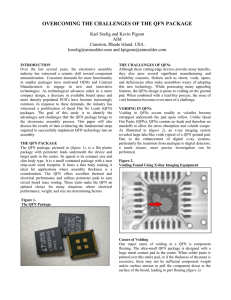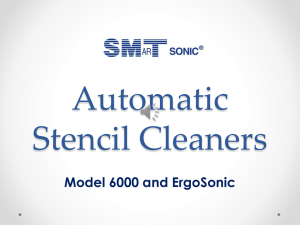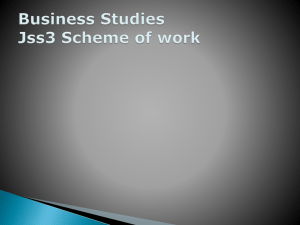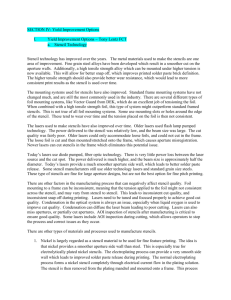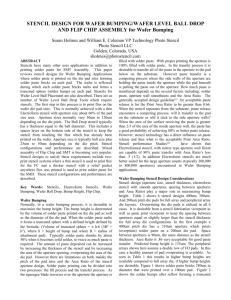BEST Business Electronics Soldering Technologies
advertisement
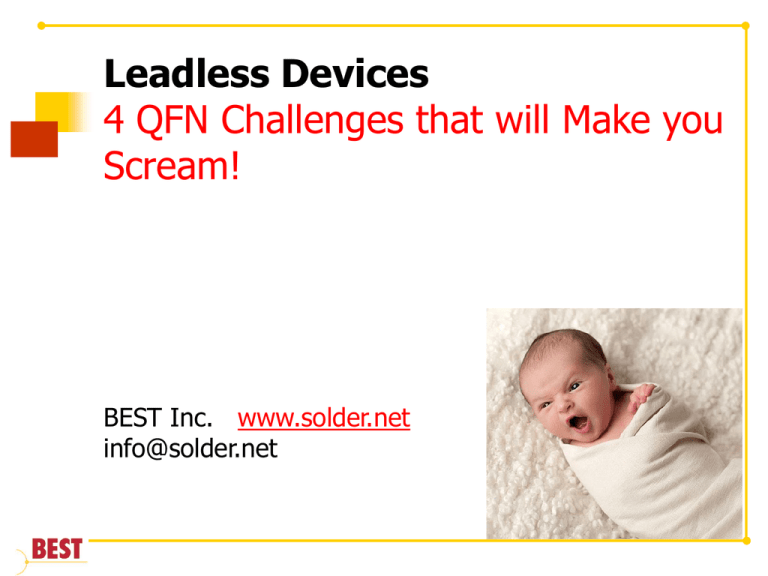
Leadless Devices 4 QFN Challenges that will Make you Scream! BEST Inc. www.solder.net info@solder.net Bottom Terminated Components The 4 “Biggies” Void Reduction Cleaning Inspection Rework 1. Void Reduction Achieve Reliable Assembly with Minimal Voiding Large area in thermal ground, lots of volume of flux, lots of outgassing Voiding impedes thermal transfer, reducing the efficiency and lifetime of the package No single approach has proven to be the solution Important to reduce overall % voids and size of largest void Try combinations of proven approaches to achieve the best possible process Solder paste is ~50% flux by volume • Large paste deposit contains volatiles • During reflow volatiles must escape to accomplish complete coalescence • Low standoff leaves no exit for excess volatiles Strategies to Reduce Voiding Thermal pad and via design Stencil design Reflow profile optimization Thermal Pad Design Considerations Strategy: break up thermal pad to discourage large voids and facilitate venting “Window paning” creates pathways to vent volatiles Reduced pockets of volatiles cause smaller voids and less overall voiding Downside: Vent channels result in less solder joint continuity Split Thermal Pads Split thermal pads reduce the size of voids, but do not significantly reduce the total voiding area For thermal transfer, large voids are more disruptive -> smaller voids allow for more transfer Solder mask defined pads offer further improvement Dr. Lee et al. study this in “The Effect of Thermal Pad Patterning on QFN Voiding” Dr. Lee et al. study this in “The Effect of Thermal Pad Patterning on QFN Voiding” Voiding in QFN Unfilled Via-in-pad This is why you must “seal” via-in-pad ! Voiding + Via in Pad • Voiding even with Pad window Paning! • Excessive voids can also cause co-planarity issues and open QFN joints • IPC & JEDEC stipulates at least 50% coverage criteria for the thermal pad. Stencil Design Instead of printing one large square at the center of QFNs: With greater paste volume, voiding increases, so aperture designs that limit paste volume will reduce voiding Break up this square into smaller apertures Spaces between printed areas leave paths for volatiles to escape “Influence of Reflow Profile and Pb-free Solder Paste in Minimizing Voids for QFN Assembly” by T. Jensen, E. Briggs et al. Effects of Window Paning W Coleman; “Printing and Assembly Challenges for QFN Devices”; SMT Magazine, 4/11 Voiding vs. Stencil Thickness Songninluck, et al; “QUAD FLAT NO LEAD (QFN) PACKAGE PROCESSING IN HIGH THERMAL MASS ASSEMBLY”; SMTAI-10 Voiding vs. Window Pane “Focal Dot” 8mil spacing Songninluck, et al; “QUAD FLAT NO LEAD (QFN) PACKAGE PROCESSING IN HIGH THERMAL MASS ASSEMBLY”; SMTAI-10 Reflow Profiling There is no “magic” reflow profile to minimize voiding For each assembly, the best profile will balance several requirements: Thermal requirements of assembly Optimal profile for the chosen solder paste Requirements of other components (ie BGAs) There will be an optimal profile, it may or may not minimize voiding Profiling must be considered but not a solution 2. Cleaning Underneath BTCs Low clearance Large center pad High paste/flux volume Difficult cleaning flow path BTC: No-Clean Residue Issues No-Clean: Solvents can’t escape => residue not safe (even though full time/temp exposure) Flux volatilization is a critical factor with regard to the complexity of the flux residue so that it becomes benign The fluxes are not benign until they have seen enough heat to volatilize the solvents create the insulative residue this can only be done with enough heat and removal of the flux carrier Courtesy of Foresite Inc BTC No-Clean Residue Issue In a no-clean process, when the flux is activated and fully volatilizes, it leaves a benign residue with no impact on field performance. But when this solvent is not allowed to release: Flux residue is conductive and moisture absorbing. Product in the field for 9 months to still have gooey conductive flux causing performance problems. BTC: No-Clean Residue Issues T Munson; “ELECTRICAL LEAKAGE FAILURES DUE TO ENTRAPPED FLUX BELOW A QFN PACKAGE”; SMTAI-06 BTC Cleaning Need to have enough standoff distance (min’m 2.5mils) Need to have pathways for the cleaning solutions to get enough impingement energy to the “soils” Need to have enough kinetic energy to break soils free Measure using ion chromatography BTC Cleaning Study Courtesy Zestron 3. Inspection AOI: Pretty worthless Manual: Depends on wettable surface Endoscope (edge viewing optical microscope) reasonable for edge joints X-Ray: good for voiding, bridges, wetting only method for central pad IPC Inspection Criteria Pullback vs. No-pullback V Solberg; “ PCB Design Principles for QFN and Other Bottom Termination Components”; APEX-11 Metallization-easier inspection Shadowing; Solder Balls Multiple pads different AOI Algorithms More Defects; CT Scan Bastin & Krastev; “QFN PROCESS CONTROL VIA 2D AND 3D CT X-RAY INSPECTION TECHNIQUES “; SMTAI-11 4. Rework High Yield, Simple and Fast IPC 7711 3.11 Rework Technique IPC 7711 3.11 Rework Technique IPC 7711 3.11 Part Bumping Using a Polyimide Peel-n-Stick Stencil(s) IPC 7711 5.8.1.2. Step #1 Align and apply stencil to device. Roll solder paste through apertures. Part Bumping Using a Polyimide Peel-n-Stick Stencil(s) Step #2 Reflow per solder mfr’s profile recommendations Part Bumping Using a Polyimide Peel-n-Stick Stencil(s) Step #3 Remove stencil and clean. Surface now is “bumped” Part Bumping Using a Polyimide Peel-n-Stick Stencil(s) Inspection of “bumped” device Part Bumping Using a Polyimide Peel-n-Stick Stencil(s) Step #4 Prep land area on PCB where device is to be placed Part Bumping Using a Polyimide Peel-n-Stick Stencil(s) Step #5 Align and adhere board stencil on PCB. Roll solder paste into apertures and clean off residue. Part Bumping Using a Polyimide Peel-n-Stick Stencil(s) Step #6 Place “bumped” QFN into stencil apertures. Feel the “bumps” fit into the apertures Part Bumping Using a Polyimide Peel-n-Stick Stencil(s) Step #7 Reflow as per solder paste manufacturers’ profile recommendations. Perform visual inspection. Perform X-ray inspection. Print Quality Print Reliability BEST Inc. bwet@solder.net www.solder.net
